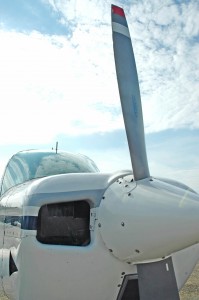
Last post, we left you finishing the preflight of the tail, or empennage, section of the plane. We checked the vertical and horizontal stabilizers as well as the rudder, elevators, trim tab, and all the hinge bolts. We also checked the antennaes, and then moved forward on the right side of the plane to check the right wing, the same as we did when we preflighted the left wing. This puts us at the front of the plane, ready to check the cowling, engine, and propeller.
NOTE: the specifics in this series apply to Cessna 172 aircraft, as that is what I instruct in most – in any case, always use the Pilot Operating Handbook (POH) for your aircraft to confirm that you have not missed anything on your preflight!
Now for the right side of the engine cowling and the front of the plane.
On the right side of the cowling, there is an access door where you can check the engine’s oil level – open this up and unscrew the dipstick. Different engines have different oil capacities, so check with an instructor and read the POH for your particular plane. Add oil if necessary – make sure you add the right oil type. Check with your instructor or a mechanic if you are unsure. While you are in here, take a look at the hoses and wires you can see, and make sure a mechanic didn’t accidentally leave a tool or rag in there somewhere!
Duck down at this point to look at the nose gear. You should see a few inches of silver on the strut – too little brings the propeller too close to the ground and is dangerous. I tell my students to look for 3-4 finger-widths of strut to be showing. Look also at the shimmy-dampener (this looks like a small shock absorber mounted sideways), and look at the strut’s “scissors” and collar for cracks or broken bolts. If these look broken, the plane should not be flown. While under here, do you see any fresh oil on the ground? If so, the engine may be leaking – that’s a no-go situation.
Moving to the front of the plane, run your hand along the edge of the propeller, looking for any dings or cracks that could weaken the prop. Grab the propeller at the base (near the middle, on both sides of the spinner) and tug. There should be no give. Check the crews in the spinner itself for any missing ones. Look inside the cowling at the engine itself – are the cooling vanes broken? Are there plates in front of the engine that are cracked and loose, or do they all look secure? Has a bird built a nest in the front of the cowling? Look for the alternator belt and reach in and tug lightly on it – it should give just a little, but be pretty taut in general, and not be worn or frayed. You should also be looking here for tools or rags that may have been left inadvertently if the plane came out of maintenance recently.
The air filter (bottom front of the cowling) should be relatively clean and not blocked by anything.
Look at the nose gear from the front to get a different perspective on it. Again, check the collars and scissors from this angle for cracks.
Now move back to the right side of the cowling (where we started). Take another look at the static port (it never hurts to check twice), and then look at the nose gear from this side as well for issues with the collars and scissors and bolts.
If all is well, the exterior check should only take a few minutes. 10-15 minutes is not unreasonable when you are learning a new airplane, but you’ll get faster as you get more familiar with the make and model of plane you are flying.
Once the exterior preflight is complete, we can move on to checking the fuel quality. This is the last step before you fire up the engine and show gravity who’s boss!
Do you do anything different on this part of the preflight? Add your tips to the comments!
Andrew Hartley is a Certificated Flight Instructor in Columbus, Ohio.
Preflight Series:
Preflight Step 1: The Cockpit Check
Preflight Step 2: Exterior (Wing)
Preflight Step 2: Exterior (Tail)
Preflight Step 2: Exterior (Engine)
Preflight Step 3: Fuel
Excellent reminders, I’ll add the following:
Make sure the keys are out of the ignition and visible on the dash before starting the propeller inspection. Check all static ports as there may be more than one.
I don’t believe i read anything about check the fuel to see if it is clear as well as the see how much fuel you have.
Sorry! Saw it at the bottom! I never knew to check the alternator belt though! Thanks!